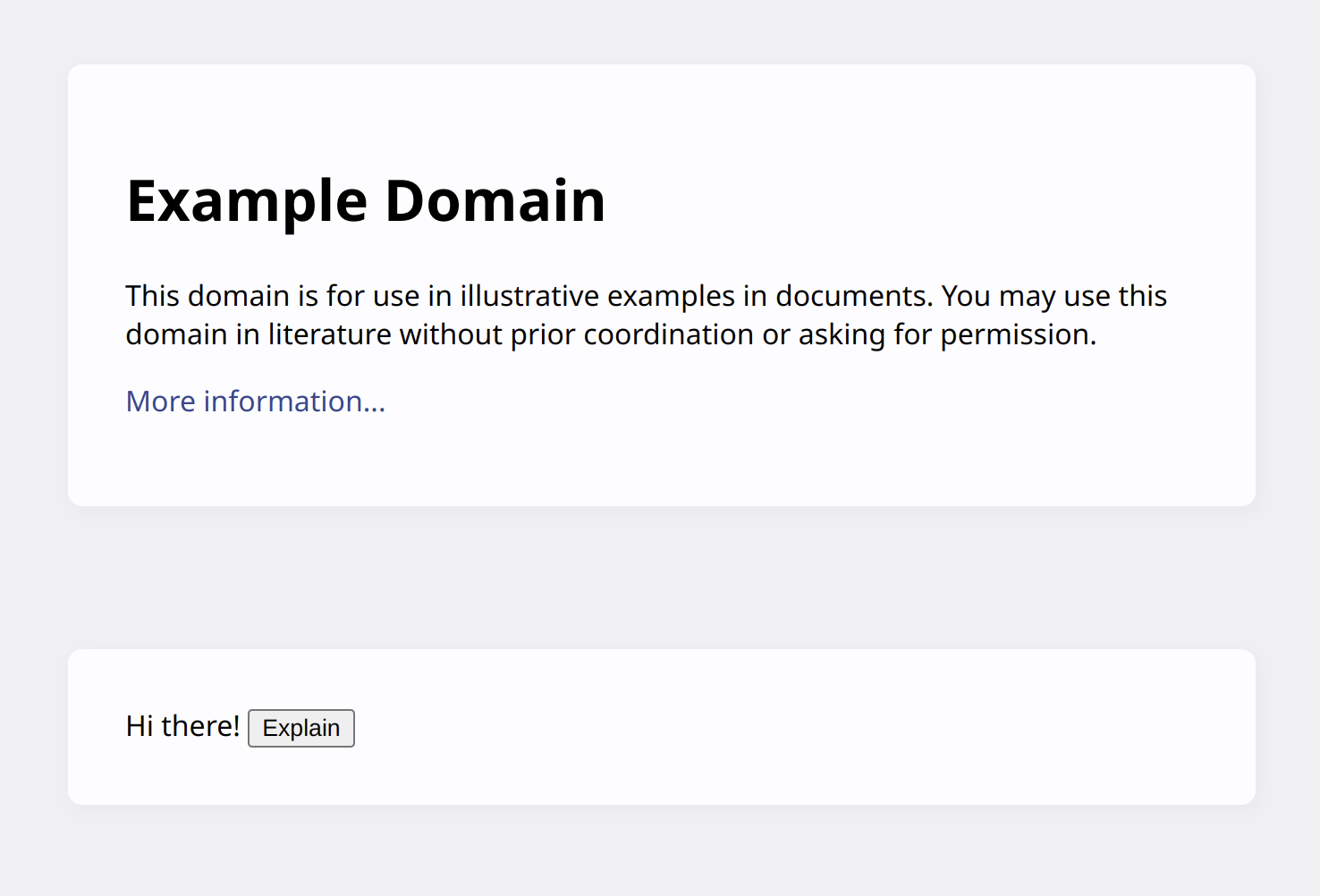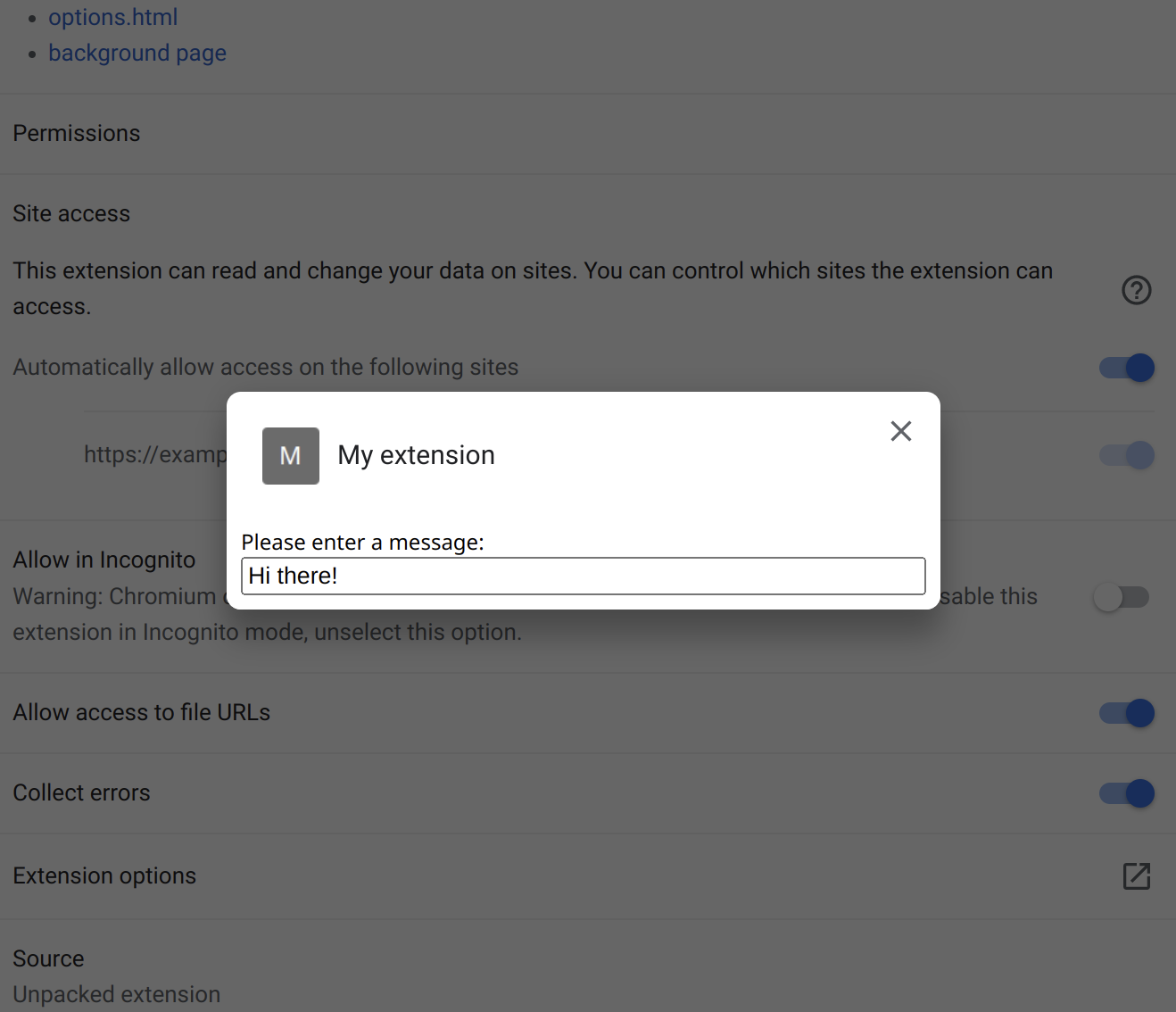Summary
a generated background page such as
chrome-extension://ffdhgjkakefolmigapfdgbcneopmidbf/_generated_background_page.html
will be loaded soon afer extensions service init.
the content of background page is generated by GeneratedBackgroundPageJob.
specially for scheme «chrome-extension://»
GenerateBackgroundPageContents
#3 0x56110ab93b63 extensions::(anonymous namespace)::GeneratedBackgroundPageJob::GetData() #4 0x7fb7125791e9 net::URLRequestSimpleJob::GetRefCountedData() #5 0x7fb712578baf net::URLRequestSimpleJob::StartAsync() extensions::CreateExtensionProtocolHandler
void ProfileIOData::SetUpJobFactoryDefaultsForBuilder( net::URLRequestContextBuilder* builder, content::URLRequestInterceptorScopedVector request_interceptors, std::unique_ptr protocol_handler_interceptor) const < // NOTE(willchan): Keep these protocol handlers in sync with // ProfileIOData::IsHandledProtocol(). #if BUILDFLAG(ENABLE_EXTENSIONS) DCHECK(extension_info_map_.get()); // Check only for incognito (and not Chrome OS guest mode GUEST_PROFILE). bool is_incognito = profile_type() == Profile::INCOGNITO_PROFILE; builder->SetProtocolHandler(extensions::kExtensionScheme, extensions::CreateExtensionProtocolHandler( is_incognito, extension_info_map_.get())); #endif GeneratedBackgroundPageJob
#2 0x55593de3c42e extensions::(anonymous namespace)::GeneratedBackgroundPageJob::GeneratedBackgroundPageJob() #3 0x55593de3b4cd extensions::(anonymous namespace)::ExtensionProtocolHandler::MaybeCreateJob() #4 0x7f0f359c0352 net::URLRequestJobFactoryImpl::MaybeCreateJobWithProtocolHandler() #5 0x7f0f359ba13e net::URLRequestInterceptingJobFactory::MaybeCreateJobWithProtocolHandler() #6 0x7f0f359ba13e net::URLRequestInterceptingJobFactory::MaybeCreateJobWithProtocolHandler() #7 0x7f0f359ba13e net::URLRequestInterceptingJobFactory::MaybeCreateJobWithProtocolHandler() #8 0x7f0f359ba13e net::URLRequestInterceptingJobFactory::MaybeCreateJobWithProtocolHandler() #9 0x7f0f359ba13e net::URLRequestInterceptingJobFactory::MaybeCreateJobWithProtocolHandler() #10 0x7f0f359ba13e net::URLRequestInterceptingJobFactory::MaybeCreateJobWithProtocolHandler() #11 0x55593f4ea748 ProtocolHandlerRegistry::JobInterceptorFactory::MaybeCreateJobWithProtocolHandler() #12 0x7f0f359c0c5f net::URLRequestJobManager::CreateJob() #13 0x7f0f35981e78 net::URLRequest::BeforeRequestComplete() LoadURL(«chrome-extension://ffdhgjkakefolmigapfdgbcneopmidbf/_generated_background_page.html»)
[20357:20357:0120/200335.076376:INFO:navigation_controller_impl.cc(659)] url chrome-extension://ffdhgjkakefolmigapfdgbcneopmidbf/_generated_background_page.html #2 0x7f4943d1ba52 content::NavigationControllerImpl::LoadURL() #3 0x56433d6fdc98 extensions::ExtensionHost::LoadInitialURL() #4 0x56433d6fce59 extensions::ExtensionHost::CreateRenderViewNow() #5 0x56433d80b5ce extensions::SerialExtensionHostQueue::ProcessOneHost() CreateBackgroundHostForExtensionLoad
#2 0x557dfb4320c8 extensions::SerialExtensionHostQueue::PostTask() #3 0x557dfb432074 extensions::SerialExtensionHostQueue::Add() #4 0x557dfb3f3ffd extensions::LoadMonitoringExtensionHostQueue::Add() #5 0x557dfb323dae extensions::ExtensionHost::CreateRenderViewSoon() #6 0x557dfb3fe434 extensions::ProcessManager::CreateBackgroundHost() #7 0x557dfb40381e extensions::(anonymous namespace)::CreateBackgroundHostForExtensionLoad() #8 0x557dfb3ff6ad extensions::ProcessManager::CreateStartupBackgroundHosts() #9 0x557dfb3ff45f extensions::ProcessManager::MaybeCreateStartupBackgroundHosts() #10 0x557dfb402520 extensions::ProcessManager::Observe() #11 0x7fbea48e3558 content::NotificationServiceImpl::Notify() #12 0x557dfeed50af ExtensionService::SetReadyAndNotifyListeners() #13 0x557dfeed36a0 ExtensionService::Init() #14 0x557dfef12dc2 extensions::ExtensionSystemImpl::Shared::Init() #15 0x557dfef137a2 extensions::ExtensionSystemImpl::InitForRegularProfile() #16 0x557dfcb664ba ProfileManager::DoFinalInitForServices() #17 0x557dfcb662f3 ProfileManager::DoFinalInit() #18 0x557dfcb68093 ProfileManager::AddProfile() #19 0x557dfcb599f2 ProfileManager::CreateAndInitializeProfile() #20 0x557dfcb59547 ProfileManager::GetProfile() #21 0x557e002cda08 GetStartupProfile() #22 0x557dfc6dd99f (anonymous namespace)::CreatePrimaryProfile() #23 0x557dfc6db686 ChromeBrowserMainParts::PreMainMessageLoopRunImpl() #24 0x557dfc6da8ec ChromeBrowserMainParts::PreMainMessageLoopRun() #25 0x7fbea41181e4 content::BrowserMainLoop::PreMainMessageLoopRun() Anatomy of a basic extension
I am starting an article series explaining the basics of browser extension security. It’s meant to provide you with some understanding of the field and serve as a reference for my more specific articles. You can browse the extension-security-basics category to see other published articles in this series.
Before we go for a deeper dive, let’s get a better understanding of what a browser extension actually is. We’ll take a look at a simple example extension and the different contexts in which its code runs.
Contents
Browser extensions? What kind of browser extensions?
Browser extensions were introduced to the general public by Mozilla more than two decades ago. Seeing their success, other browser vendors developed their own extension models. However, Google Chrome becoming the prevalent browser eventually caused all the other extension models to go extinct. At this point in time, only Chrome-compatible extensions are still relevant.
These extensions are supported by Google Chrome itself and other Chromium-based browsers such as Microsoft Edge, Opera or Vivaldi. The Mozilla Firefox browser uses an independent implementation of the extension APIs, the only one as far as I am aware. While mostly compatible, Mozilla’s extension APIs have been improved in some areas. Some of these improvements have security impact but, the extension development being centered on Google Chrome these days, I doubt that many extension developers are aware.
Another interesting aspect is that Mozilla for Android also supports extensions, unlike the mobile versions of Google Chrome. This is merely of theoretical importance however as only add-ons from a very short list can be installed. Two years ago I’ve voiced my concern about this restrictive approach, yet as of today this list still contains only ten browser extensions.
So our example extension is going to be a Chrome-compatible one. I’ll discuss the files one by one but you can download the entire source code to play around with here. Unpack this ZIP file to some directory.
All browsers support trying out extensions by loading them from a directory. In Chromium-based browsers you go to chrome://extensions/ , enable developer mode and use “Load unpacked” button. In Firefox you go to about:debugging#/runtime/this-firefox and click “Load Temporary Add-on” button.
This extension uses questionable approaches on purpose. It has several potential security issues, none of these are currently exploitable however. Small changes to the extension functionality will change that however, I’ll introduce these in future articles.
The central piece of an extension is its manifest, a file named manifest.json . Ours looks like this:
"manifest_version": 2, "name": "My extension", "version": "1.0", "permissions": [ "storage" ], "content_scripts": [ "js": [ "script.js" ], "matches": [ "https://example.com/*", "https://www.example.com/*" ] > ], "background": "scripts": [ "background.js" ] >, "options_ui": "page": "options.html" > > We use manifest version 2 here. Eventually manifest version 3 is supposed to replace it completely. Yet in my current survey of extension manifests only 16% of all extensions used the newer version.
This manifest declares that the extension requires the storage permission. This means that it can use the storage API to store its data persistently. Unlike cookies or localStorage APIs which give users some level of control, extension storage can normally only be cleared by uninstalling the extension.
It also declares that this extension contains the content script script.js , an options page options.html and a background script background.js . We’ll take a look at all of these next.
Content scripts are loaded whenever the user navigates to a matching page, in our case any page matching the https://example.com/* expression. They execute like the page’s own scripts and have arbitrary access to the page’s Document Object Model (DOM). Our content script uses that access to display a notification message:
chrome.storage.local.get("message", result => let div = document.createElement("div"); div.innerHTML = result.message + " "; div.querySelector("button").addEventListener("click", () => chrome.runtime.sendMessage("explain"); >); document.body.appendChild(div); >); This uses the storage API to retrieve the message value from extension’s storage. That message is then added to the page along with a button labeled “Explain”. This is what it looks like on example.com :
What happens when this button is clicked? The content script uses runtime.sendMessage() API to send a message to the extension pages. That’s because a content script only has direct access to a handful of APIs such as storage . Everything else has to be done by extension pages that content scripts can send messages to.
The content script capabilities differ slightly depending on browser. For Chromium-based browsers you can find the list in the Chrome Developers documentation, for Firefox MDN is the ultimative source.
Usually, when content scripts send a message its destination is the background page. The background page is a special page that is always present unless specified otherwise in the extension manifest. It is invisible to the user, despite being a regular page with its own DOM and everything. Its function is typically coordinating all other parts of the extension.
Wait, our extension manifest doesn’t even define a background page! There is only a background script. How does that work?
There is still a background page. It is called _generated_background_page.html and contains the following code:
body> script src="background.js">script> If a background page isn’t declared explicitly, the browser will helpfully generate one automatically and make sure all the declared background scripts are loaded into it.
And here is our background script:
chrome.runtime.onMessage.addListener((request, sender, sendResponse) => if (request == "explain") chrome.tabs.create( url: "https://example.net/explanation" >); > >) It uses runtime.onMessage API to listen to messages. When an «explain» message is received, it uses tabs API to open a page in a new tab.
But how did that message text get into extension storage? Probably via an option page allowing to configure the extension.
Browser extensions can contain various kinds of pages. There are for example action pages that are displayed in a drop-down when the extension icon is clicked. Or pages that the extension will load in a new tab. Unlike the background page, these pages aren’t persistent but rather load when needed. Yet all of them can receive messages from content scripts. And all of them have full access to extension-specific APIs, as far as the extension’s permissions allow.
Our extension manifest declares an options page. This page displays on top of the extension details if some user manages to find the button to open it which browser vendors hide rather well:
It’s a regular HTML page, nothing special about it:
html> head> script src="options.js">script> head> body> Please enter a message: input id="message" style="width: 100%;"> body> html> The script loaded by this page makes sure that any changes to the message field are immediately saved to the extension storage where our content script will retrieve them:
function init() let element = document.getElementById("message"); chrome.storage.local.get("message", result => element.value = result.message); element.addEventListener("input", () => chrome.storage.local.set( message: element.value >); >); > window.addEventListener("load", init, once: true >); Altogether the relevant contexts for browser extensions look like this:
In this article we’ve already seen content scripts that can access websites directly but are barred from accessing most of the extension APIs. Instead, content scripts will communicate with extension pages.
The extension pages are way more powerful than content scripts and have full access to extension APIs. They usually won’t communicate with websites directly however, instead relying on content scripts for website access.
Desktop applications and connected websites are out of scope for this article. We’ll take a thorough look at them later.


